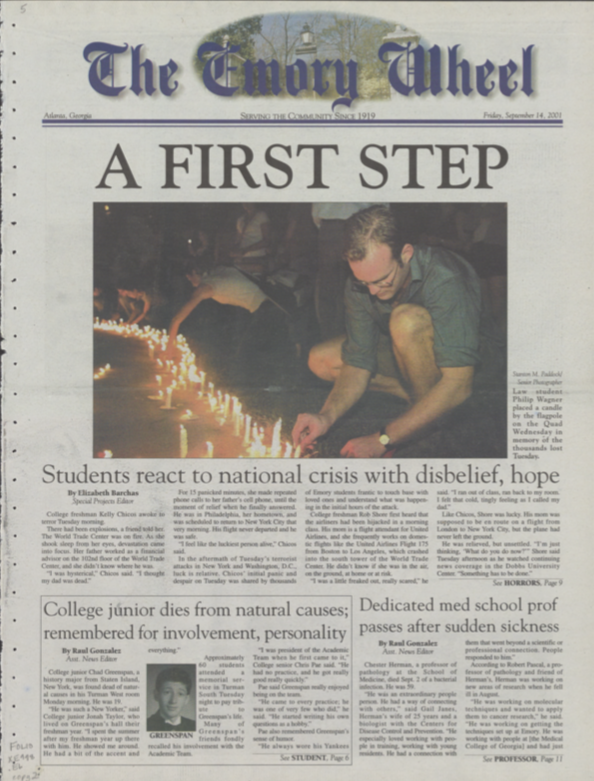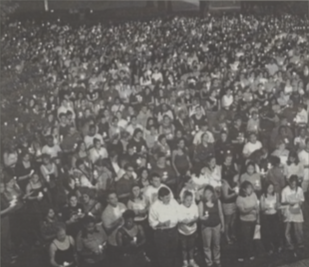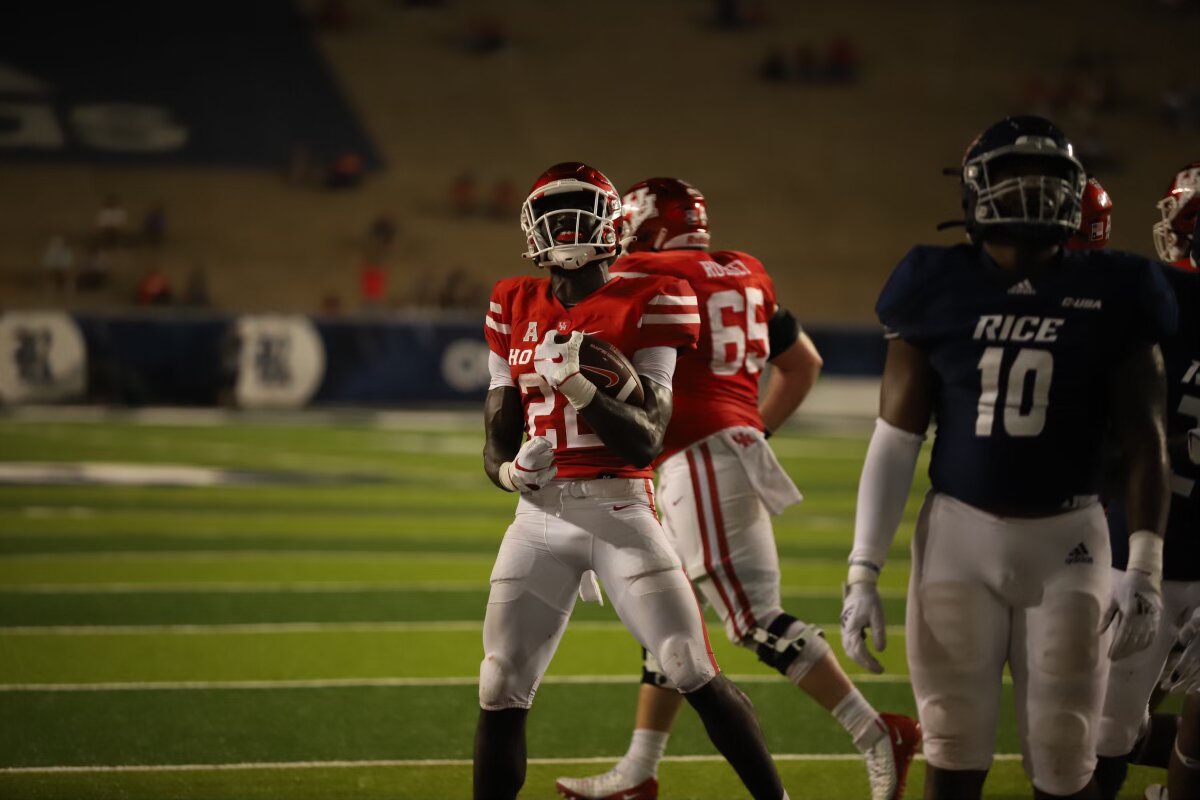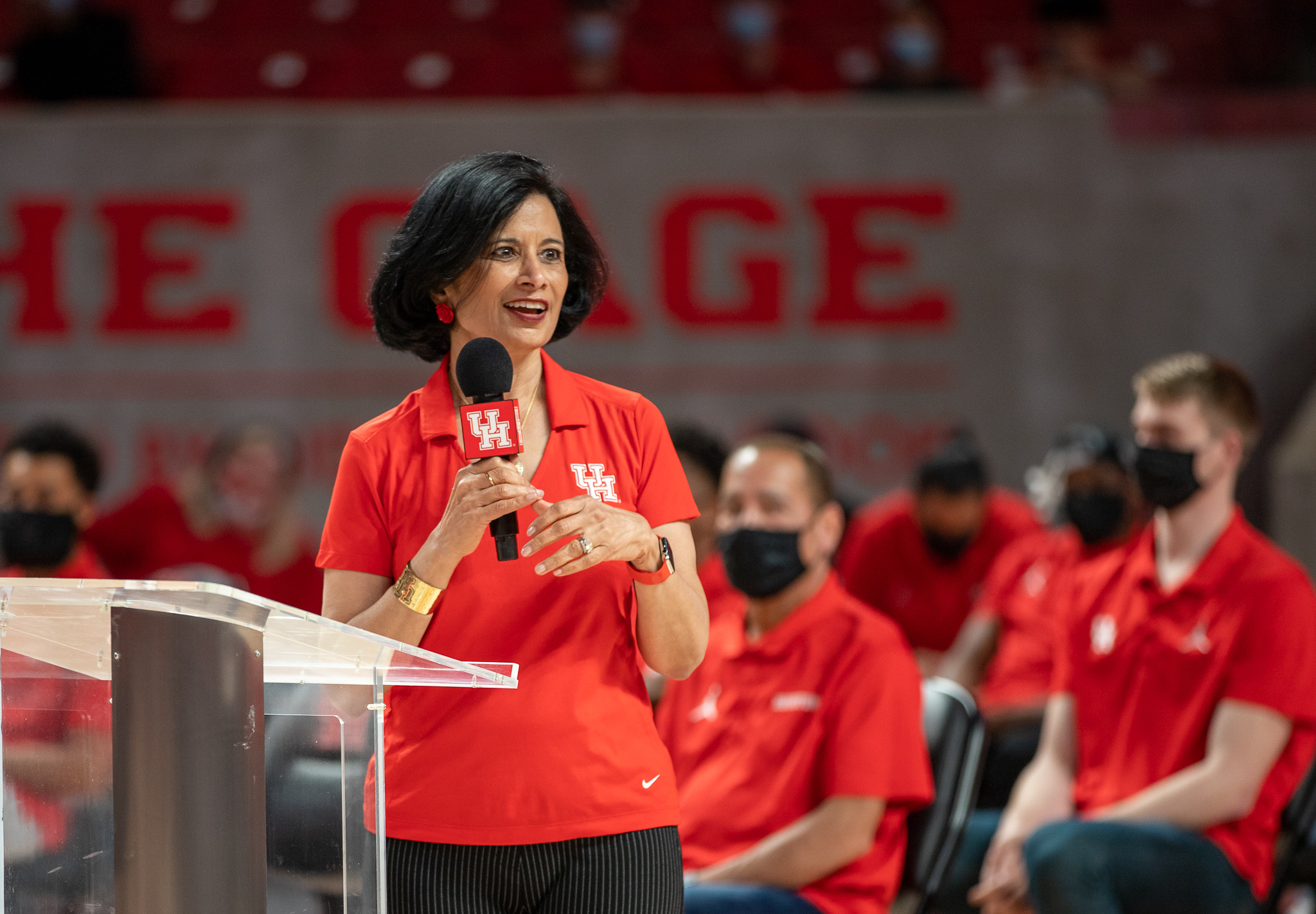Posted on 12 September 2021.
Editor’s note: This story was published in the Wheel’s first issue on Friday, Sept. 14, 2001, following the events of 9/11.
College freshman Kelly Chicos awoke to terror Tuesday morning.
There had been explosions, a friend told her. The World Trade Center was on fire. As she shook sleep from her eyes, devastation came into focus. Her father worked as a financial advisor on the 102nd floor of the World Trade Center, and she didn’t know where he was.
“I was hysterical,” Chicos said. “I thought my dad was dead.”
For 15 panicked minutes, she made repeated phone calls to her father’s cell phone, until the moment of relief when he finally answered. He was in Philadelphia, her hometown, and was scheduled to return to New York City that very morning. His flight never departed and he was safe.
“I feel like the luckiest person alive,” Chicos said.
In the aftermath of Tuesday’s terrorist attacks in New York and Washington, D.C., luck is relative. Chicos’ initial panic and despair on Tuesday was shared by thousands of Emory students frantic to touch base with loved ones and understand what was happening in the initial hours of the attack.

The first issue of The Wheel after Sept. 11 featured interviews with students in the wake of the attack. (Emory Wheel)
College freshman Rob Shore first heard that the airliners had been hijacked in a morning class. His mom is a flight attendant for United Airlines, and she frequently works on domestic flights like the United Airlines Flight 175 from Boston to Los Angeles, which crashed into the south tower of the World Trade Center. He didn’t know if she was in the air, on the ground, at home or at risk.
“I was a little freaked out, really scared,” he said. “I ran out of class, ran back to my room. I felt that cold, tingly feeling as I called my dad.”
Like Chicos, Shore was lucky. His mom was supposed to be en route on a flight from London to New York City, but the plane had never left the ground.
He was relieved, but unsettled. “I’m just thinking, ‘What do you do now?’” Shore said Tuesday afternoon as he watched continuing news coverage in the Dobbs University Center. “Something has to be done.”
Students turned to one another for comfort in the early hours of the attack, often openly sobbing in the DUC and other public areas. Dozens formed lines to try to reach family and friends on public telephones until administrators made additional phones available. Many dissected the events of the morning with one another. Others were unable to put words to their terror and watched silently.
“It’s just unreal to watch all of this,” said College freshman Laura White, indicating what was on TV as well as what was happening on campus. White was one of hundreds of students mesmerized by the large TV screen in the DUC Coca-Cola Commons. “Just seeing 200 people standing around here,” she said. “I’m a little bit numb, a little bit in shock.”
College sophomore Anna Scruggs’ eyes filled with tears as she stood in the DUC Tuesday morning. “A guy in my last class has family in [the World Trade Center],” she said. “He watched it collapse on itself. I’m crying for him. I hope everything is OK. To have known someone there, I can’t imagine.
A sign on the front door of Dobbs Hall explained that residents were watching the news together in a common area “just so we have each other,” the sign read.
College freshman Brian Offen was one of many students who gathered in Dobbs. “We’re all just watching, seeing if anything new has come up,” he said early Tuesday afternoon.
He said he had been glued to the TV for hours straight. “I’m not going to work today,” Offen said. “It’s hard to focus when there’s a tragedy.”
After Offen heard about the attack from his roommate, he spent more than two hours trying to locate family members who live in Long Island, N.Y.
“All the phones were tied up,” he said. “I just wanted to touch base with them, to see how they’re doing.”
College freshman Justin Karp joined the group in Dobbs. “It’s better to experience things with friends, to share ideas,” said Karp, of New Rochelle, N.Y.
When Karp’s resident advisor woke him in the morning to describe what had happened and ask if Karp’s family was safe, Karp said, “I completely freaked out.”
By Tuesday afternoon, after finding that his loved ones weren’t hurt, Karp’s initial panic turned into a general sadness.
Students seeking answers to why the tragedy happened were able to find some comfort from counselors, who were available starting late Tuesday morning.
By 11:30 a.m., the Student Government Association had begun working with administrators to help develop a response, according to SGA President Anna Manasco. SGA executive members helped coordinate the memorial service in Glenn Memorial Auditorium Tuesday evening, and helped publicize counseling resources. By Wednesday morning, SGA had organized a blood drive in conjunction with the School of Medicine and the Office of Residence Life.
“I think [the tragedy] has shown Emory is a resilient community,” Manasco said. “It’s a human community, and people are grieving for themselves and for others. But at the same time, they are interested in how we can work through this together.”
Manasco and SGA representatives and members of the Emory community at large quickly mobilized to help each other without prompting, likely because they wanted to do something, anything.

More than 2,000 students, faculty and staff gathered on the Quadrangle Sept. 11, 2001 for prayer, songs and a moment to grieve. Some students shared their personal reactions to the crisis. (Stanton M. Paddock, 2001)
College freshman Greg Galant said he understood the desire to be active. “You feel helpless being here in Atlanta with everything going on out there,” said Galant, of Huntington, Long Island.
Galant spent Tuesday afternoon watching news coverage alone in his room in Harris Residence Hall, after mourning with friends earlier in the day. The pictures on TV shocked him, he said.
“When I saw the World Trade Center fall, my heart just stopped,” he said. “I go into the city a lot. I’m an hour from there, and just returning to New York City without the World Trade center is hard for me.”
He said that he imagines it must be even harder for those who lost friends or family. One of Galant’s hallmates was initially unable to reach a parent who worked in the World Trade Center, he said. “He couldn’t find anything out,” he said. “He tried calling over and over.”
Eventually, the friend heard that his father had taken the day off to go golfing and was safe. “I can’t imagine what that is like, if you had a family member who did work there,” Galant said.
It’s all hard to imagine, Galant said. The horror and destruction. The grief and anger. The hows and whys. The future.
“It really hit me when I was walking back from the DUC, what had happened to New York and to the country,” he said. “There’s been so much loss of life and property. It’s the type of thing that will change how we live.”
Editor’s note: This story has been edited to omit a quote which may be harmful for some readers.
The post From the archives: Students react to national crisis with disbelief, hope appeared first on The Emory Wheel.










